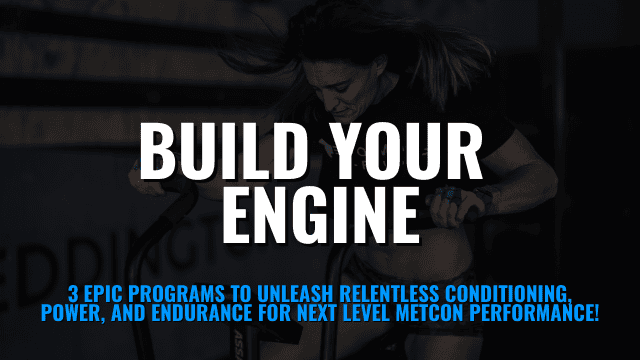
Rethinking Conditioning for Fitness Athletes – Build Your Engine Episode 1

Rethinking Conditioning for Fitness Athletes – Build Your Engine Episode 1
In this episode, Zachary Long and Johnny B delve into the complexities of conditioning and endurance training, particularly in the context of CrossFit. They discuss various methods to improve conditioning, the importance of understanding individual strengths and weaknesses, and how energy systems play a crucial role in performance. The conversation highlights the interplay between strength and conditioning, emphasizing that effective training requires a nuanced approach tailored to the athlete’s specific needs. “Rethinking Conditioning for Fitness Athletes” sets the stage for a deeper exploration of energy systems in future discussions.
Download the Build Your Engine eBook here!
Need proven programs to unleash your engine? Check out our Build Your Engine programs!
Episodes
- Rethinking Conditioning
- How Energy Systems Drive Performance
- Accessory Conditioning WODs You Need to Train (releasing 12/23)
- Wrist vs. Chest Heart Rate Monitors (releasing 12/23)
Takeaways
- You need to identify your weaknesses to improve conditioning.
- Conditioning involves understanding various energy systems.
- Zone 2 cardio is essential for endurance athletes.
- Strength plays a significant role in conditioning performance.
- Different athletes require different training focuses.
- The complexity of CrossFit requires a tailored approach.
- High relative intensity affects conditioning outcomes.
- Energy systems are interconnected with muscular systems.
- Understanding your max strength is crucial for conditioning.
- Future discussions will explore energy systems in detail.
Chapters
- 00:00 Introduction to Conditioning and Endurance Training
- 02:55 Understanding the Engine: Energy Systems in Conditioning
- 06:11The Importance of Individual Strength and Conditioning
- 09:01 The Interplay of Strength and Conditioning
- 11:55 Complexities of CrossFit and Conditioning
- 15:08 Looking Ahead: Energy Systems Explained
Rethinking Conditioning for Fitness Athletes – Podcast Summary
Developing conditioning, or “engine,” is vital for CrossFit athletes who aim to excel in the sport’s diverse and demanding workouts. In this episode of the Performance Plus Podcast, Zach Long and endurance expert Johnny B dive into the complexities of conditioning for functional fitness athletes, discussing strategies and debunking misconceptions along the way.
What Does “Building Your Engine” Mean?
In the CrossFit community, improving your “engine” refers to enhancing the body’s ability to produce energy efficiently across various workouts, regardless of whether you’re lifting heavy, performing gymnastics, or running. Johnny emphasizes that conditioning is not just about doing more Echo Bike intervals—it involves optimizing energy systems for diverse demands, from high-intensity sprints to longer aerobic efforts.
Debunking Conditioning Myths
The conversation started after Zach noticed a wide range of responses to a Reddit thread about improving CrossFit conditioning. Suggestions ranged from Zone 2 cardio and interval work to stopping CrossFit entirely in favor of endurance training. But the reality is that building a well-rounded engine is far more nuanced than simply sticking to one training method.
The Key to Effective Conditioning: Identify and Target Weaknesses
Johnny stresses that to improve conditioning, athletes must first identify their weak points and tailor their training accordingly. Here’s how to approach it:
1. Assess Your Conditioning Weaknesses
- Use workout results to identify whether you struggle with long, steady efforts (Zone 2), moderate-intensity workouts (Zone 3), or short, intense efforts (VO2 Max).
- For instance, if an athlete excels in high-rep wall ball workouts but struggles with Fran (21-15-9 of thrusters and pull-ups), their threshold training may need more attention.
2. Train All Energy Systems
Effective CrossFit conditioning requires a focus on all energy systems:
- Zone 2 training: Steady-state, lower-intensity cardio that improves aerobic capacity.
- Threshold training: Higher-intensity work at the upper end of Zone 4, improving sustained performance near the lactate threshold.
- VO2 Max intervals: Max-effort bursts that improve the ability to sustain high output.
- Athletes should also train the “in-between” zone, or Zone 3, which serves as a steady pace for longer workouts like marathons.
3. Know Your Baseline Strength and Its Impact on Conditioning
- Conditioning in CrossFit is not just about heart rate and endurance—it also involves strength. For instance, an athlete with a 500-pound deadlift will find Diane (21-15-9 of deadlifts and handstand push-ups) easier than someone whose max deadlift is only 275 pounds, as they operate at a lower percentage of their max strength.
- Having a higher strength base allows athletes to maintain efficiency during mixed-modal workouts and reduces reliance on fast-twitch muscle fibers, prolonging aerobic performance.
The Importance of Specific Programming
CrossFit athletes often mistakenly think they can build aerobic capacity just by doing more CrossFit metcons. But effective conditioning requires specific programming that balances aerobic development with strength adaptations.
1. Consider Training History and Genetics
- Athletes with an endurance background may not need much Zone 2 work, while strength-focused athletes may benefit significantly from it.
- Genetic factors can also influence which energy systems athletes are naturally better at utilizing, making individualized training critical.
2. Design Workouts That Simulate Competition
To truly improve conditioning, athletes must replicate the competition experience by mixing heavy lifts, gymnastics, and cardio in a controlled training environment.
Why Elite CrossFit Athletes Stand Out
The ability of elite athletes to combine exceptional strength, aerobic capacity, and bodyweight skills is what makes them unique. It’s not just about being able to deadlift 500 pounds or run a sub-5-minute mile; it’s about doing both in the same day while still performing advanced gymnastics movements. These athletes have mastered the integration of energy systems, making them capable of adapting to various workout demands.
Final Thoughts: Start with the Basics, Then Progress
Whether you’re new to CrossFit or an experienced competitor, improving conditioning is not a one-size-fits-all endeavor. Athletes need to identify specific weaknesses, focus on all energy systems, and consider how strength impacts conditioning.
In upcoming episodes, Zach and Johnny will break down the different energy systems and how to program workouts for each, helping CrossFit athletes build a complete engine. Stay tuned to learn more about how to optimize your training for better performance!





